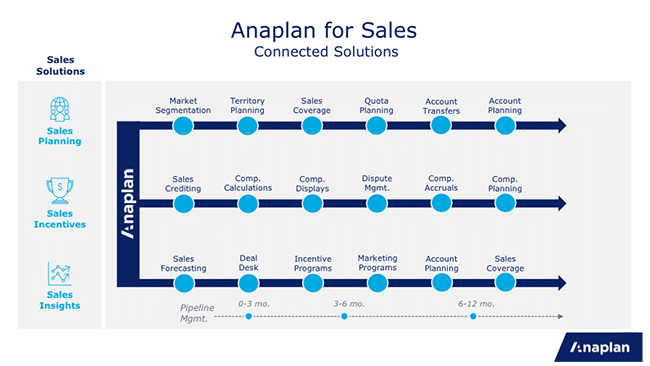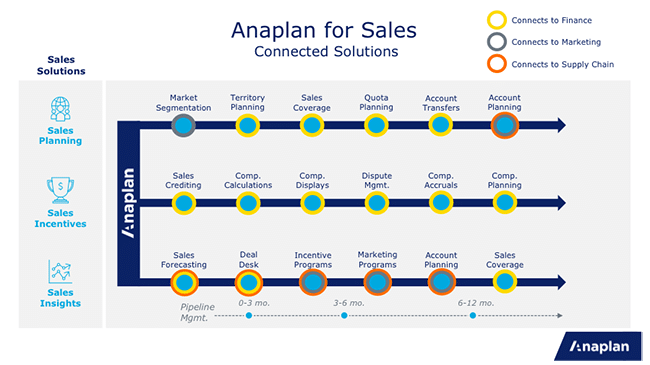Sales planning and performance management: two sides of the same coin


For sales managers, planning for the future can feel quite different from stomping out fires in the present. The future’s a rosy dream world, where pipelines are always full, reps always meet their targets, and business strategies never change. The present? A molten ball of chaos, requiring immediate attention, all the time.
Mostly, we separate sales planning and sales performance management (SPM) along these lines: planning is what you do before the year begins and performance management is part of your day-to-day activity.
With Anaplan for sales, these approaches shift. As I explained at Hub 2018, when you implement Connected Planning, sales planning and performance management become two sides of the same coin. Ultimately, they feed into each other, so that your future plans inform the way you manage in the present, and managing performance in the present becomes a way of planning for the future. Here is a clip from the presentation:
The sales pitchfork: blending present and future
At bottom, your ultimate goal is to meet your company’s annual operating plan (AOP) targets. In sales performance management (SPM), this means effectively managing your territories, accounts, and pipeline. Doing this, in turn, means thinking about three things: sales planning, sales incentives, and sales insights.
At Anaplan, we link these three sub-journeys, providing an end-to-end solution that covers their many use-cases. We call it the “sales pitchfork.”
The top row of the pitchfork, sales planning, spells out the use cases that achieve your annual sales targets: territory and quota design, coverage, and account planning. The middle row, sales incentives, is about managing your incentive compensation all the way through, from plan design and administrative management to reporting and insights. On the bottom, our sales insights solution tells you how healthy your pipeline is and helps you determine the best way to manage it.
Pipeline management is deeply linked to sales forecasting. That’s why the bottom row of the pitchfork spells out the pipeline activities you should be thinking about both now and in the future. Zoom in on this bottom row for a minute. On the left end of it there are use cases like deal desk, which you need for negotiating and closing a deal; as you move further to the right, it shifts to activities that set you up for the future, like hiring more reps, or changing your sales coverage.
Pulled together, this information gives sales managers a four-quarter view of the decisions they’ll need to manage their pipeline. The result: a way of managing performance that actively considers both how that performance will shape decisions in the future, and how future decisions might shape the way you manage performance.
Connecting across the organization
The pitchfork is also useful for thinking about how your SPM strategy might connect with other areas of your business—finance, marketing, and supply chain, in particular. Below, you can see the pitchfork annotated with additional colors to show all the use cases where what you do in SPM impacts the rest of your organization.
Again, let’s focus on the bottom row. Sales forecasting, for example, drives demand forecasting, as well as sales and operations planning. So once you start connecting everything, the capabilities you need to do driver-based modeling, or scenario planning, are there at your fingertips.
In fact, once we start thinking in broader terms, we see that the beauty of Anaplan is that all your use cases sit on the larger Anaplan platform. Everything is there: your data, data models, drivers, entities like territories and quotas—if you make a change in any of these, the information smoothly flows from one model to all the others. If you’re changing territories and quotas throughout the year, for example, in Anaplan, those changes flow right into compensation. Or when you close a sale, you want to make sure you can actually deliver everything you’ve sold. In Anaplan, sales data quickly moves into your supply chain processes, ensuring that you can deliver everything you’ve promised.
How to begin connecting sales planning and sales performance management
If you’re in any if these solution journeys—any of the individual rows of the pitchfork—we recommend that you first enable all of the use cases in that row, bringing them all together in one platform. Once you’ve done that, you’re ready to connect all three rows. This is how you connect individual use cases to the larger goal we started with: achieving your AOP targets.
For most businesses, these are huge pain points. But with Anaplan connecting everything across the sales pitchfork (and beyond), you gain access to all the levers you need—in addition to standardization and trust across the organization—to meet your AOP targets.


